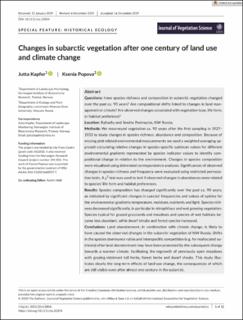| dc.contributor.author | Kapfer, Jutta | |
| dc.contributor.author | Popova, Ksenia | |
| dc.date.accessioned | 2021-03-18T09:44:12Z | |
| dc.date.available | 2021-03-18T09:44:12Z | |
| dc.date.created | 2020-04-23T13:21:33Z | |
| dc.date.issued | 2019-12-27 | |
| dc.identifier.citation | Journal of Vegetation Science (JVS). 2020, 32 (1), . | en_US |
| dc.identifier.issn | 1100-9233 | |
| dc.identifier.uri | https://hdl.handle.net/11250/2734099 | |
| dc.description.abstract | Questions Have species richness and composition in subarctic vegetation changed over the past ca. 90 years? Are compositional shifts linked to changes in land management or climate? Are observed changes associated with vegetation type, life form, or habitat preference? Location Rybachy and Sredny Peninsulas, NW Russia. Methods We resurveyed vegetation ca. 90 years after the first sampling in 1927–1930 to study changes in species richness, abundance and composition. Because of missing plot‐related environmental measurements we used a weighted averaging approach calculating relative changes in species‐specific optimum values for different environmental gradients represented by species indicator values to identify compositional change in relation to the environment. Changes in species composition were visualised using detrended correspondence analyses. Significances of observed changes in species richness and frequency were evaluated using restricted permutation tests. A χ2 test was used to test if observed changes in abundances were related to species’ life form and habitat preferences. Results Species composition has changed significantly over the past ca. 90 years, as indicated by significant changes in species’ frequencies and values of optima for the environmental gradients temperature, moisture, nutrients and light. Species richness decreased significantly, in particular in nitrophilous and wet growing vegetation. Species typical for grazed grasslands and meadows and species of wet habitats became less abundant, while dwarf shrubs and forest species increased. Conclusions Land abandonment, in combination with climate change, is likely to have caused the observed changes in the subarctic vegetation of NW Russia. Shifts in the species dominance ratios and interspecific competition (e.g. for reallocated nutrients) after land abandonment may have been promoted by the subsequent change towards a warmer climate, facilitating the regrowth of previously open meadows with grazing‐intolerant tall herbs, forest herbs and dwarf shrubs. This study illustrates clearly the long‐term effects of land‐use change, the consequences of which are still visible even after almost one century in the subarctic. | en_US |
| dc.language.iso | eng | en_US |
| dc.publisher | John Wiley & Sons Ltd. | en_US |
| dc.rights | Navngivelse 4.0 Internasjonal | * |
| dc.rights.uri | http://creativecommons.org/licenses/by/4.0/deed.no | * |
| dc.title | Changes in subarctic vegetation after one century of land use and climate change | en_US |
| dc.type | Peer reviewed | en_US |
| dc.type | Journal article | en_US |
| dc.description.version | publishedVersion | en_US |
| dc.rights.holder | © 2020 The Authors. | en_US |
| dc.source.pagenumber | 12 | en_US |
| dc.source.volume | 32 | en_US |
| dc.source.journal | Journal of Vegetation Science (JVS) | en_US |
| dc.source.issue | 1 | en_US |
| dc.identifier.doi | 10.1111/jvs.12854 | |
| dc.identifier.cristin | 1807691 | |
| dc.relation.project | Norges forskningsråd: 194051 | en_US |
| cristin.ispublished | true | |
| cristin.fulltext | original | |
| cristin.qualitycode | 1 | |

